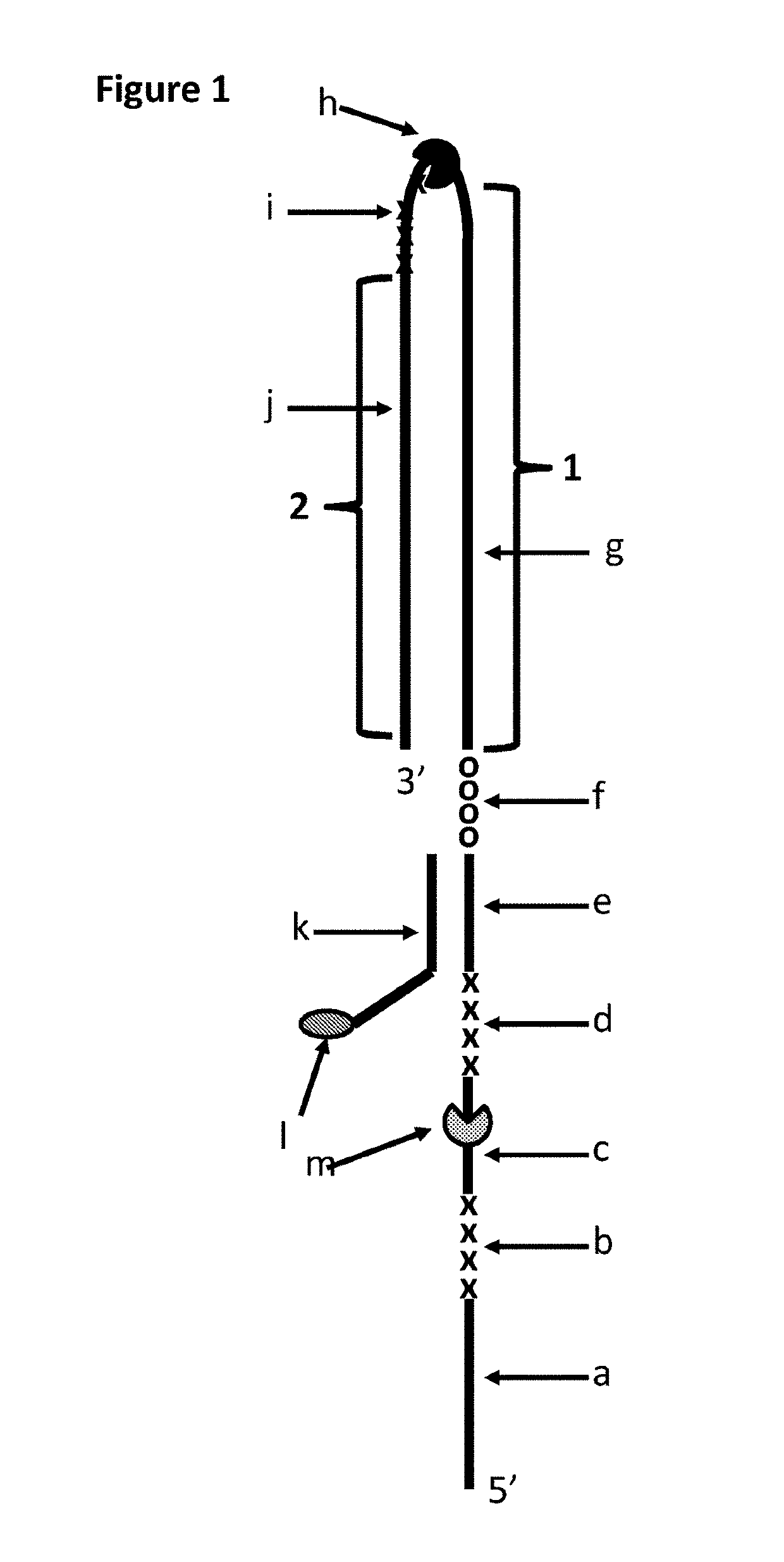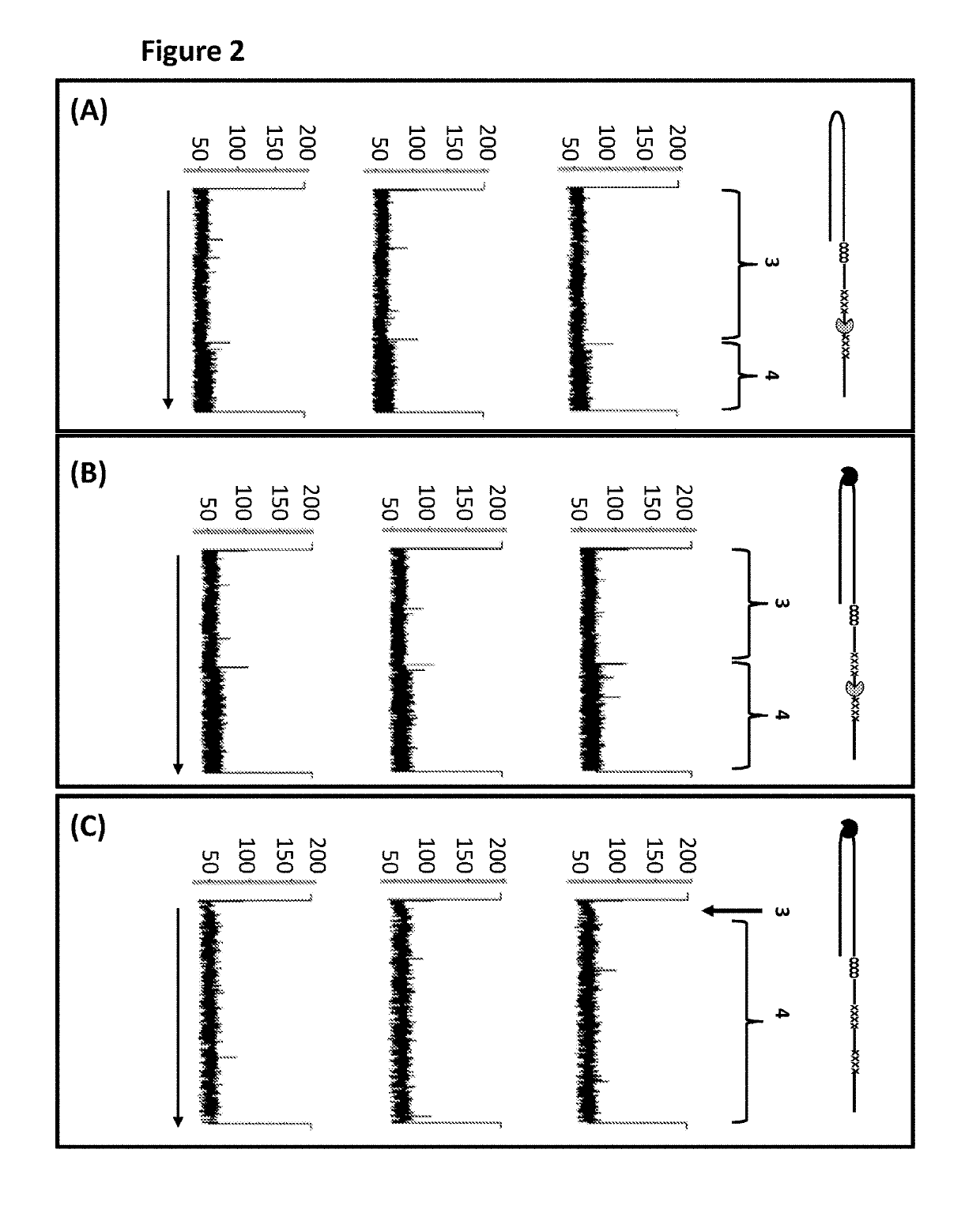Method for controlling the movement of a polynucleotide through a transmembrane pore
a technology of transmembrane pores and polynucleotides, which is applied in the direction of instruments, biochemical apparatus and processes, and material electrochemical variables, etc., can solve the problems of slow and expensive existing technologies
- Summary
- Abstract
- Description
- Claims
- Application Information
AI Technical Summary
Benefits of technology
Problems solved by technology
Method used
Image
Examples
example 1
[0369]This example compared the use of a single T4 Dda—E94C / A360C to T4 Dda—E94C / A360C and TrwC Cba-Q594A (SEQ ID NO: 25 with the mutation Q594A) in tandem in order to control the movement of DNA construct Y (shown in FIG. 1) through an MspA nanopore. T4 Dda—E94C / A360C is an active helicase which moved along the DNA when provided with appropriate fuel, whereas, TrwC Cba-Q594A is an inactive helicase (which has had its helicase activity knocked out) and therefore acted as a molecular brake. When two different helicases were used to control the movement of the construct through the nanopore then improved movement was observed in comparison to when the movement was controlled by a single helicase.
[0370]The Dda helicase used in this Example moves along the polynucleotide in a 5′ to 3′ direction. When the 5′ end of the polynucleotide (the end away from which the helicase moves) is captured by the pore, the helicase works with the direction of the field resulting from the applied potentia...
example 2
[0381]This example compared the use of a single T4 Dda—E94C / C109A / C136A / A360C to T4 Dda—E94C / C109A / C136A / A360C and TrwC Cba-Q594A (SEQ ID NO: 25 with the mutation Q594A) in tandem in order to control the movement of DNA construct Y (shown in FIG. 1) through an MspA nanopore. T4 Dda—E94C / C109A / C136A / A360C is an active helicase which moved along the DNA when provided with appropriate fuel, whereas, TrwC Cba-Q594A is an inactive helicase (which has had its helicase activity knocked out) and therefore acted as a molecular brake. When two different helicases were used to control the movement of the construct through the nanopore then improved movement was observed in comparison to when the movement was controlled by a single helicase.
Materials and Methods
[0382]Prior to setting up the experiment, the DNA construct Y pre-mix was prepared as described in Example 1 except the first helicase to be incubated with the DNA was T4 Dda—E94C / C109A / C136A / A360C instead of T4 Dda—E94C / A360C.
[0383]Elec...
example 3
[0388]This example compared the use of a single T4 Dda—E94C / C109A / C136A / A360C to T4 Dda—E94C / C109A / C136A / A360C and TrwC Cba-L376C / Q594A / K762C (SEQ ID NO: 25 with mutations L376C / Q594A / K762C) in tandem in order to control the movement of DNA construct Y (shown in FIG. 1) through an MspA nanopore. T4 Dda—E94C / C109A / C136A / A360C is an active helicase which moved along the DNA when provided with appropriate fuel, whereas, TrwC Cba-L376C / Q594A / K762C is an inactive helicase (which has had its helicase activity knocked out) and therefore acted as a molecular brake. This helicase has also been mutated in order to reduce the size of an opening in the polynucleotide binding domain through which in at least one conformational state the polynucleotide can unbind from the helicase. When two different helicases were used to control the movement of the construct through the nanopore then improved movement was observed in comparison to when the movement was controlled by a single helicase.
Materials ...
PUM
| Property | Measurement | Unit |
|---|---|---|
| voltage | aaaaa | aaaaa |
| voltage | aaaaa | aaaaa |
| temperature | aaaaa | aaaaa |
Abstract
Description
Claims
Application Information
 Login to View More
Login to View More - R&D
- Intellectual Property
- Life Sciences
- Materials
- Tech Scout
- Unparalleled Data Quality
- Higher Quality Content
- 60% Fewer Hallucinations
Browse by: Latest US Patents, China's latest patents, Technical Efficacy Thesaurus, Application Domain, Technology Topic, Popular Technical Reports.
© 2025 PatSnap. All rights reserved.Legal|Privacy policy|Modern Slavery Act Transparency Statement|Sitemap|About US| Contact US: help@patsnap.com



